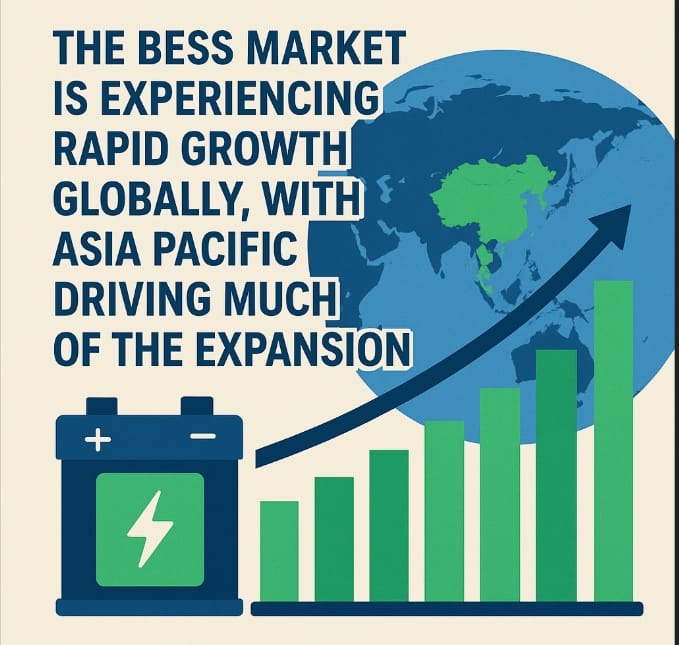BESS Market Asia Pacific: Battery Energy Storage Systems (BESS) are no longer a niche technology—they’ve become a vital pillar of the clean energy transition. As renewable energy capacity soars worldwide, so does the need for scalable, reliable, and cost-effective energy storage. Today, Asia Pacific (APAC) stands firmly at the forefront of this global expansion.
⚡ Global BESS Market Outlook
- The BESS market is witnessing unprecedented growth. In 2024, its global value was estimated at USD 25 billion, and it’s projected to surge to USD 114 billion by 2032, with a CAGR of 19.6% (Fortune Business Insights).
- Markets and Markets predicts a jump from USD 7.8 billion in 2024 to USD 25.6 billion by 2029, marking a CAGR near 27%.
- Grand View Research sees similar trends, forecasting nearly USD 58.8 billion by 2030, at an annual growth rate of around 33% from 2024–2030.
This growth is being fueled by rising demand for renewable integration, grid stability, peak shaving, and energy independence across both developed and emerging economies.
🌏 Asia Pacific: The Growth Engine
According to recent reports:
✅ APAC accounted for nearly half (~49%) of the global BESS market share in 2024.
✅ The region’s market is projected to expand rapidly at CAGRs ranging from 27–30% over the next decade.
✅ By 2034, APAC’s BESS market could exceed USD 28–49 billion, with China, South Korea, India, Japan, and Australia driving much of this growth.
🔑 What’s Fueling APAC’s BESS Boom?
- Renewable Energy Rollouts:
Countries like China and India are deploying massive solar and wind capacity. For example, China aims to reach 1,200 GW of renewables by 2030. Without robust storage, much of this clean energy would be wasted. - Strong Policy Support:
Governments offer direct subsidies, tenders, and incentives for grid-scale and behind-the-meter storage projects. India’s National Energy Storage Mission and Australia’s energy transition roadmap are prime examples. - Cost Declines in Battery Technologies:
The cost of lithium-ion battery packs has dropped from around $1,000/kWh in 2010 to ~$139/kWh in 2023. This makes large-scale BESS more viable than ever. - Gigafactory Expansion:
Leading battery makers like CATL, BYD, LG, and Samsung SDI continue to expand production. The surge in local gigafactories reduces costs and supply chain risks. - Diverse Applications:
BESS is being used for microgrids in remote islands, backup power for data centers, telecom towers, and to support EV charging infrastructure.
🥊 APAC’s Regional Players: A Quick Look
🇮🇳 India:
Heavily investing in grid-scale storage to support its ambitious 500 GW renewables target by 2030. The focus is also on decentralized rural applications.
🇨🇳 China:
Dominates the global BESS space with massive capacity additions and large-scale projects that can power entire cities. Its manufacturing leadership in lithium-ion batteries is unmatched.
🇰🇷 South Korea:
LG Energy Solution and Samsung SDI are shifting to more cost-effective chemistries like LFP to stay competitive amid global trade challenges.
🌟 Why It Matters
- Grid Stability: Keeps power flowing even when renewables fluctuate.
- Energy Security: Reduces dependence on fossil fuels.
- Cost Efficiency: Enables peak shaving and demand charge reduction.
- Sustainability: Integrates circular economies by reusing EV batteries for stationary storage.
✅ Key Takeaway
Asia Pacific is not just a participant—it’s the powerhouse of the global BESS boom.
From policy momentum to technology innovation and sheer scale, APAC is setting the pace for how the world will store and use clean energy.
As costs drop and technology matures, expect the BESS revolution to reach deeper into our grids, our businesses, and even our homes.
Final Thoughts
The coming years will define the winners of the energy transition. For businesses, investors, and policymakers, understanding how Asia Pacific shapes this market is critical. Whether you’re sourcing BESS solutions, developing new projects, or planning to enter emerging markets—now is the time to plug into this growth story.
🔗 References:



